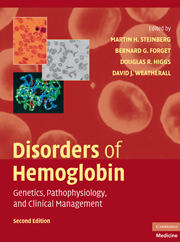Book contents
- Frontmatter
- Contents
- List of Contributors
- Foreword, by H. Franklin Bunn
- Preface
- Introduction, by David J. Weatherall
- SECTION ONE THE MOLECULAR, CELLULAR, AND GENETIC BASIS OF HEMOGLOBIN DISORDERS
- SECTION TWO PATHOPHYSIOLOGY OF HEMOGLOBIN AND ITS DISORDERS
- SECTION THREE α THALASSEMIA
- SECTION FOUR THE β THALASSEMIAS
- SECTION FIVE SICKLE CELL DISEASE
- SECTION SIX OTHER CLINICALLY IMPORTANT DISORDERS OF HEMOGLOBIN
- 24 Unstable Hemoglobins, Hemoglobins with Altered Oxygen Affinity, Hemoglobin M, and Other Variants of Clinical and Biological Interest
- 25 Dyshemoglobinemias
- SECTION SEVEN SPECIAL TOPICS IN HEMOGLOBINOPATHIES
- SECTION EIGHT NEW APPROACHES TO THE TREATMENT OF HEMOGLOBINOPATHIES AND THALASSEMIA
- Index
- Plate section
- References
25 - Dyshemoglobinemias
from SECTION SIX - OTHER CLINICALLY IMPORTANT DISORDERS OF HEMOGLOBIN
Published online by Cambridge University Press: 03 May 2010
- Frontmatter
- Contents
- List of Contributors
- Foreword, by H. Franklin Bunn
- Preface
- Introduction, by David J. Weatherall
- SECTION ONE THE MOLECULAR, CELLULAR, AND GENETIC BASIS OF HEMOGLOBIN DISORDERS
- SECTION TWO PATHOPHYSIOLOGY OF HEMOGLOBIN AND ITS DISORDERS
- SECTION THREE α THALASSEMIA
- SECTION FOUR THE β THALASSEMIAS
- SECTION FIVE SICKLE CELL DISEASE
- SECTION SIX OTHER CLINICALLY IMPORTANT DISORDERS OF HEMOGLOBIN
- 24 Unstable Hemoglobins, Hemoglobins with Altered Oxygen Affinity, Hemoglobin M, and Other Variants of Clinical and Biological Interest
- 25 Dyshemoglobinemias
- SECTION SEVEN SPECIAL TOPICS IN HEMOGLOBINOPATHIES
- SECTION EIGHT NEW APPROACHES TO THE TREATMENT OF HEMOGLOBINOPATHIES AND THALASSEMIA
- Index
- Plate section
- References
Summary
Hemoglobin can bind gases other than oxygen (O2). These include carbon monoxide (CO) and nitric oxide (NO). Carboxyhemoglobin (COHb) precludes normal O2 transport and is toxic. Nitrosohemoglobin has critical physiological functions discussed in Chapter 10. Normal hemoglobin can be oxidized to methemoglobin and sulfhemoglobin by exogenous agents and these hemoglobin forms can also be found as a result of germline mutations. In aggregate, these modified hemoglobins, referred as dyshemoglobinemias, are the basis of a group of acquired and genetic disorders that are rare but can have serious clinical implications.
METHEMOGLOBINEMIA
Methemoglobin is formed when the iron of the heme group is oxidized or converted from the ferrous (Fe2+) to the ferric (Fe3+) state. The ferric hemes of methemoglobin are unable to reversibly bind O2. In addition, the presence of ferric heme increases the O2 affinity of the accompanying ferrous hemes in the hemoglobin tetramer. This leads to a left shift in the hemoglobin–O2 dissociation curve, which impairs tissue delivery of O2. Normally, methemoglobin is generated and then reduced physiologically to maintain a very low steady-state blood methemoglobin level of 1% or less of the total hemoglobin. The half-life of methemoglobin is approximately 1 hour if the reductase mechanism is normal. Methemoglobinemia occurs when there is imbalance between methemoglobin production and methemoglobin reduction. Methemoglobinemia can have both inherited and acquired causes; hemoglobin oxidation has been recently reviewed.
Pathophysiology of Methemoglobinemia
Production of Methemoglobin. O2 binds the ferrous form of iron present in hemoglobin to form oxyhemoglobin.
- Type
- Chapter
- Information
- Disorders of HemoglobinGenetics, Pathophysiology, and Clinical Management, pp. 607 - 622Publisher: Cambridge University PressPrint publication year: 2009
References
- 12
- Cited by



